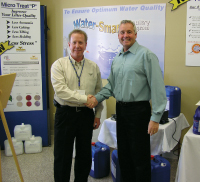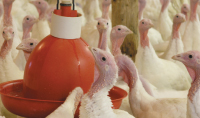
Not To Be Ignored
Kristy Nudds
Features New Technology ProductionA water management plan is essential
Monitoring water quality and implementing a water management plan is essential for healthy flocks
Although it comprises 70 per cent of a bird’s body and is essential for nearly every bodily function, water is a nutrient that is often overlooked.
Dr. Susan Watkins, Associate Professor and a Poultry Extension Specialist at the University of Arkansas, has told countless poultry industry audiences around the world that water quality must be something a producer continuously strives for.
 |
| ENSURING CLEAN WATER Water is an essential nutrient that is too often ignored. A new program has been developed to make water quality management easier for producers.
|
She says nature designed the chicken and turkey to swallow whole seeds and bugs, not the ground feed that comprises modern diets. Water helps soften materials collected in the crop before they move on to the proventriculus and on to the gizzard to begin the grinding process. Whole seeds have a protective coating that prevents them from being attacked by bacteria, limiting their growth, she says.
Commercial feed is ground, removing this protective layer. This was done to aid digestion, but it also encourages bacteria, mold and yeast growth in the crop which may reduce performance and increase contamination rates, she says. If water quality is poor, the probability of contamination and adverse effects on production is greatly increased.
“Water has been ignored for too long,” says Kevin Weeden, President of Weeden Environments, a Woodstock, Ont.-based poultry product supplier that recently joined forces with United Nutrients Corporation (UNC) – Member of the Jefo Group, developing and launching a livestock water sanitation program this past April.
A crucial component of the program is to remove biofilm – the “guck” that builds up in water lines. Biofilm is a naturally occurring polysaccharide web that provides micro-organisms (bacteria, fungi, yeast and protozoa) food and something to adhere to, contaminating the water going through the lines. Problem is, it is extremely resistant to removal by ordinary sanitizing and requires the use of unique products to be fully eliminated from lines.
Limescale deposits and mineral scale can also cause problems, says Ray Halbert, founder of Keytech Water Management. These types of deposits are what help promote the development of biofilm and can lead to leaky drinkers, resulting in wet litter, which can also impact bird health.
Need to Medicate? If you need to adminster a vaccine or other medication via the water lines, it’s important that the use of chlorine and other sanitizers in the drinking water is stopped during this process. Chlorine will inactivate vaccines and reduce the effectiveness of some medications. In the case of anti-biotics, Dr. Watkins says chlorine will have varying results depending on the antibiotic you’re using. A pH above 7 works best when you are using penicillin and sulfa drugs, so Watkins recommends turning off the water acidifiers and adding ammonia with a second injector. Adding these antibiotics to water with a low pH will actually turn the resulting mixture into an insoluble product. Chlortetracycline and tetracycline work best in a low pH range. If you have high alkaline water, adding acid actually enhances absorption of these products. |
“Water is taken for granted,” he says. “Farmers often tell me that they’ve always had good water, but this is usually based only on the fact that it is clear, so it must be OK.”
Halbert has been concentrating on helping producers (mostly in the U.S.) remove scale and biofilm from their lines and helping them find the right people to assist with the other components of a good water quality control program: water analysis, and keeping the lines clean by using metering injection systems and products that maintain proper pH levels.
In his opinion, Halbert says poultry producers overuse chlorine and hydrogen peroxide. “Having metering and injection systems for these chemicals is essential,” he says.
The likely cause of chemical overuse is the fact that many producers are bombarded with differing information on water sanitation from so many sources, and end up using too much product, thinking that they are doing what they are supposed to – making sure that the water is at the correct pH level to maximize chlorine effectiveness, maintain water lines and ensure optimum bird performance.
Chlorine is commonly added to poultry drinking water to act as a “disinfectant,” i.e., to kill any micro-organisms that might be present.
Problem is, producers don’t know what’s going on in their water lines if they just add chlorine without testing the pH levels. “The swimming pool guys have been testing pH since the start, but the poultry industry hasn’t really grasped this concept,” says Weeden.
People with swimming pools are told to monitor their pH levels vigilantly because of a simple fact: chlorine loses its germ-killing efficacy when it is not at an optimal pH level.
Wanting to bring “clarity” to producers, Weeden teamed with UNC to create the “WATER-SMART” program to provide producers with the tools they need and most importantly, a program that was simple to follow.
The first step in the WATER-SMART program is for producers to get their water analyzed for pH and the scale-causing minerals: calcium, magnesium and manganese. It’s also a good idea to analyze the water for salt levels, coliforms, bacteria, fungi, protozoa, nitrates and sulphates, which can decrease performance by causing the birds to use energy to fight off their effects or make the water unpalatable, reducing water intake.
The program states that if the water contains more than 90 ppm combined calcium and manganese and more than 0.05 ppm manganese and 0.3 ppm iron, the producer will need to include a water acidifier in their line-cleaning program. An acidifier (typically a blend of inorganic and organic acid) will dissolve these mineral deposits in the water lines and fittings.

The second step in the program is to remove the biofilm. Once the biofilm is removed (according to product specifications), mineral buildup is then removed using an acidifier.
Weeden and UNC’s approach with WATER-SMART is to lower the pH of the water (they recommend a pH of 6.5) to where the chlorine added to the water works effectively. If a barn has water with a naturally high pH level, the program recommends injecting both chlorine and an acidifier to lower the pH down to where it needs to be.
Once the water in the lines is “clean,” it’s important to keep it clean, says Weeden. The objective of the program is to provide a clean source of drinking water with a continuous level of free chlorine at 3-5 ppm at the end of the building furthest from the proportioner. Weeden also stresses that biofilm will begin to grow again within 48 hours of being removed, so water lines need to be cleaned between each and every flock.
Another key component of the program is to provide producers with the tools they need to maintain clean drinking water. Weeden Environments offers monitoring tools such as ORP pens and pH strips, as well as necessary equipment, such as water pumps and injectors.
The goal of any producer is to achieve the genetic potential of their birds, says Weeden. “The WATER-SMART program helps them do this.”
While some chemical interactions can help one another to work better, the wrong chemical interaction can reduce effectiveness of the additives, not to mention the potential health consequences to both birds and humans. The following are some of the actions and interactions Dr. Watkins says that we know for certain.
ANTIBIOTICS
When it comes to dispensing antibiotics through the water system, the results will vary depending on the antibiotic you’re using. A pH above 7 works best when you are using penicillin and sulfa drugs, so Watkins recommends turning off the water acidifiers and adding ammonia with a second injector. Adding these antibiotics to water with a low pH will actually turn the resulting mixture into an insoluble product.
VACCINES AND PH
Some growers will distribute vaccines via the water system. Vaccines are typically proteins, so any time you run vaccines it should be at a pH above 4 or you will run the risk of denaturing the viral proteins and rendering the vaccine less effective or useless.
Dr. Watkins has been receiving a lot of calls regarding slime blooms in water systems after the use of antibiotics. These fungal growths are catching growers by surprise — literally clogging drinkers — but it makes perfect sense that such growth should occur, particularly with a dirty water system. The antibiotic disrupts the microbial population in the water lines just as it does in the gut, allowing microbes such as yeast and mold to grow unchecked. She recommends a thorough cleaning to remove the slime, but cautions that using an acidifier such as citric acid will only make it worse.
EFFECT OF TEMPERATURE
One other pearl of water wisdom concerns the temperature of the water used to mix your stock solutions. Dr. Watkins suggests that adding dry acidifier products to room temperature water will provide more uniform stock solutions than if cold water is used. All sanitizers lose efficacy at colder temperatures. Chlorine, chlorine dioxide and ozone are all temperature sensitive, with colder water slowing down their reaction times.
Some of the future research at the University of Arkansas will continue to test different combinations of products and evaluate new products as they arrive on the market. Dr. Watkins is also currently working on the possibility of creating an ideal water sanitization program that will help to reduce or prevent the incidence of salmonella in pullet flocks.
Admittedly all of these chemical interactions can make something as simple as water quite complicated. As Dr. Watkins says, one thing she is sure about when it comes to water: it’s almost a daily effort to make sure you’ve got it right.
Print this page